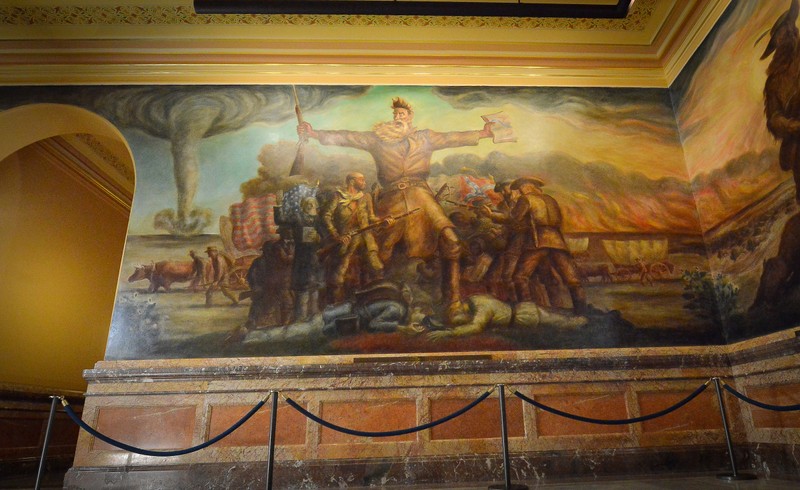“Tragic Prelude” Mural
Introduction
Text-to-speech Audio
The mural Tragic Prelude in the Kansas State Capitol was controversial for featuring a wild-eyed, larger-than-life John Brown when it was first painted in 1940, but today it hangs in the statehouse as an unforgettable part of Kansas history.
Images
The Tragic Prelude mural featuring John Brown at the Kansas State Capitol in Topeka.

Backstory and Context
Text-to-speech Audio
Tragic Prelude is a striking mural painted by John Steuart Curry from 1937 to 1940. It depicts John Brown, armed with a Bible and a rifle, standing in front of Union and Confederate soldiers while a tornado and a prairie fire approach from behind. The mural is rife with symbolism and so large that it is difficult to fully capture in a photo, measuring 33 feet by 11.5 feet. The title refers to the Bleeding Kansas period as a prelude to the Civil War.
Although the mural became Curry’s most famous work, it was highly controversial at its time of completion. Curry had been hired to portray the story of Kansas on the second floor of the building, which entailed many large murals, but Curry left the project in disgust, incomplete, after his work was hindered by the controversy. There were complaints from many members of the public over using John Brown as a focal point of one of the murals, as well as smaller details like colors and the length of a woman’s skirt. The Kansas Council of Women issued the statement, “The murals do not portray the true Kansas. Rather than revealing a law-abiding progressive state, the artist has emphasized the freaks in its history - the tornadoes, and John Brown, who did not follow legal procedure.” The Kansas Legislature passed a resolution that effectively ended Curry’s work before it was complete, so several of the murals planned to accompany Tragic Prelude on the second floor of the statehouse were never painted.
Although there were complaints about many aspects of Curry’s work, the primary cause for disagreement was its inclusion of the controversial abolitionist John Brown. Brown was raised as a Calvinist in Ohio, where as an adult he became a stationmaster on the Underground Railroad. When the Kansas-Nebraska Act passed in 1854, allowing settlers the right to decide whether their states would allow slavery, Brown’s sons soon left for Kansas. Brown did not join his sons in Kansas until 1855, when pro-slavery forces took control of the legislature. In response, Brown gathered his weapons and went to Kansas, where he led violent raids against pro-slavery forces.
Although he left behind a violent legacy, it is in part due to Brown’s actions that Kansas voted to become a free state. Today, Curry’s mural hangs in the State Capitol to pay tribute to Brown’s spirit and the importance of the abolishment of slavery in progressing democracy in the United States.
Cite This Entry
Kansas, Humanities. "“Tragic Prelude” Mural." Clio: Your Guide to History. February 28, 2023. Accessed February 15, 2025. https://theclio.com/tour/2386/29
Sources
Finkelman, Paul. A Look Back at John Brown. Prologue. https://www.archives.gov/publications/prologue/2011/spring/brown.html.
https://www.kshs.org/kansapedia/kansas-state-capitol-curry-murals/16864
https://www.kshs.org/p/kansas-state-capitol-online-tour-tragic-prelude/16595
https://www.history.com/topics/slavery/john-brown
https://americanhistory.si.edu/price-of-freedom/civil-war/john-brown
Kansas Tourism

